Following the Toronto Maple Leafs’ first-round elimination, all eyes have shifted onto Mitch Marner and his contract situation.
The star winger becomes a restricted free agent (RFA) on July 1 and will require a new contract for next season.
With the rest of the Leafs core locked into long-term deals, Marner’s contract will be the last to fall into place. But even with the sense of certainty that the deal will get done, there are plenty of challenges that may get in the way of a smooth negotiation.
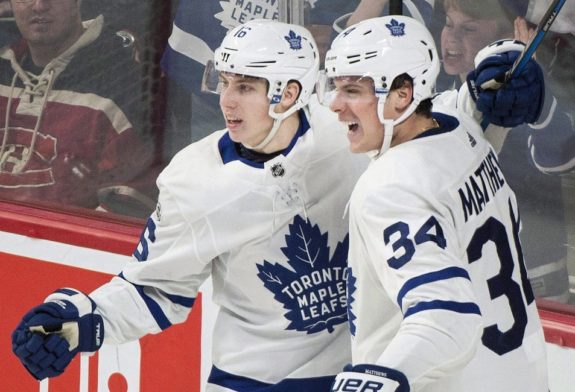
There are murmurs amongst the media that Marner is looking for Auston Matthews money, which would put him at an average annual value (AAV) of over $11 million.
Regardless of what the media, fanbase, or Marner’s group believes, the notion that he is worth the same as Matthews is far-fetched at best.
Marner’s Agent and Media Rumours
On Feb. 5, the same day that the Leafs extended Matthews, Marner’s agent Darren Ferris spoke out to the media.
“So far they’ve been trying to lowball (Marner),” Ferris told Dave Feschuk of the Toronto Star. “Nobody else is taking a discount. And now you’re asking (Marner) to take one again? It’s nonsense.”
With these comments out in the open, it became clear that negotiations would not go so smoothly and they worsened this week when Elliotte Friedman came out with more information on his 31 Thoughts.
“It is believed (Marner) is targeting the Auston Matthews deal,” Friedman said. “It is also believed that the Maple Leafs do not see him passing Patrick Kane ($10.5 million) as the highest-paid winger in the NHL. They probably want him around the Nikita Kucherov/Mark Stone $9.5-million range, although those are no-tax states.”
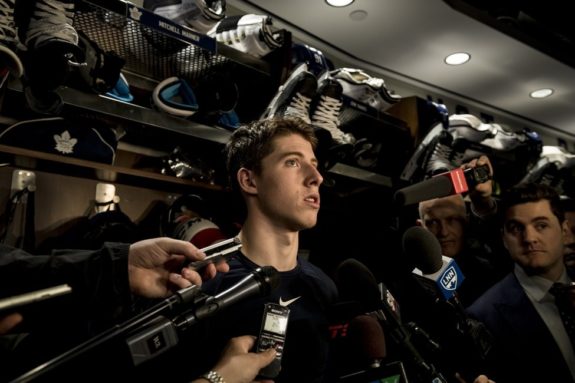
Is Ferris putting these comments out there simply to fetch Marner as much money as possible? Probably.
The next question, then, is how much influence will the rumours and media pressure have on negotiations. The answer to that is still unknown.
The only people who truly know what is going on between Marner and the Leafs are the parties involved. For the rest of us, the best we can do is speculate based on stats and comparables.
Luckily, there is plenty of information available to paint a good picture of what the 23-year-old winger is worth.
Marner vs. Matthews
First, let’s address the idea that Marner is worth as much as Matthews.
In the simplest terms, the Leafs paid Matthews $11.634 million because he plays centre (the most valuable position on the ice), can carry his own line, and has scored more even-strength goals than anyone else since entering the league.

Marner, on the other hand, plays on the wing, cannot drive play or carry a line, and just scored a career-high 26 goals.
Centres vs. Wingers
As per capfriendly.com, here are the top 20 cap hits for the upcoming 2019-20 season.
| PLAYER | POSITION | AVERAGE ANNUAL VALUE (AAV) |
|---|---|---|
| 1. Connor McDavid | C | $12,500,000 |
| 2. Auston Matthews | C | $11,634,000 |
| 3. Drew Doughty | D | $11,000,000 |
| 4. John Tavares | C | $11,000,000 |
| 5. Jonathan Toews | C | $10,500,000 |
| 6. Patrick Kane | RW | $10,500,000 |
| 7. Carey Price | G | $10,500,000 |
| 8. Anze Kopitar | C | $10,000,000 |
| 9. Jack Eichel | C | $10,000,000 |
| 10. Tyler Seguin | C/RW | $9,850,000 |
| 11. Alex Ovechkin | RW/LW | $9,538,462 |
| 12. Nikita Kucherov | RW | $9,500,000 |
| 13. Evgeni Malkin | C | $9,500,000 |
| 14. Mark Stone | RW | $9,500,000 |
| 15. Jamie Benn | LW | $9,500,000 |
| 16. P.K. Subban | D | $9,000,000 |
| 17. Sidney Crosby | C | $8,700,000 |
| 18. Corey Perry | RW | $8,625,000 |
| 19. Steven Stamkos | C | $8,500,000 |
| 20. Henrik Lundqvist | G | $8,500,000 |
Notice that 10 of the 20 highest paid players in the league are centres. In comparison, only six primarily play winger. Outside of the top 50 forwards, the trend continues: 27 of them are centres.
This illustrates a pattern and precedent. A centre is considered the most important position on the ice and are paid accordingly.
Goals vs. Assists
Poetically, goals are to assists as centres are to wingers. That is to say, general managers pay big bucks for goals and even more for centres who score goals, as was the case with Matthews.
Marner is a terrific player and does a ton of great things for the Leafs, but he is not is a prolific goal scorer.
In 2018-19, Marner scored 26 goals, good for 71st in the league amongst forwards. In terms of goals-per-60 (G/60), which measures how efficient a player is at scoring given their ice time, Marner ranked 135th in the league at 0.96 G/60. That is slightly better than teammate Kasperi Kapanen (0.93 G/60) and slightly worse than linemate Zach Hyman (1.03 G/60).
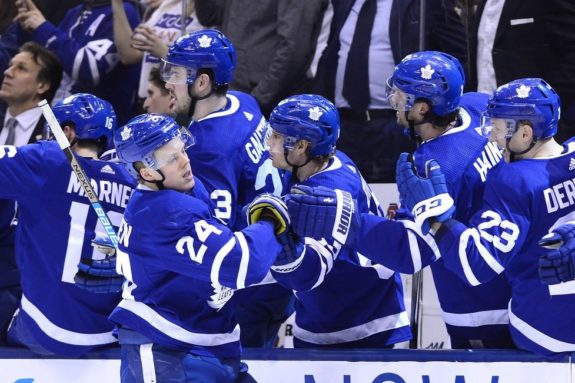
Kasperi Kapanen (THE CANADIAN PRESS/Frank Gunn) 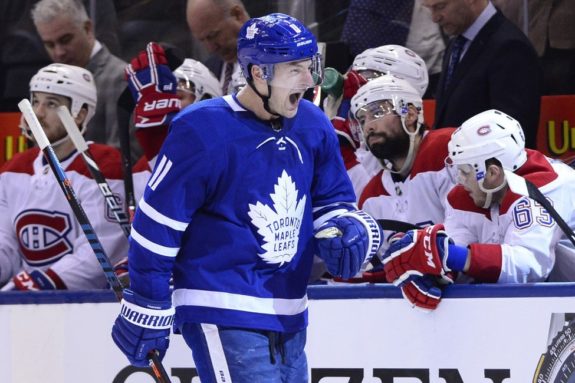
Zach Hyman (THE CANADIAN PRESS/Frank Gunn)
Fellow Leafs John Tavares and Matthews ranked fifth and sixth respectively in G/60. They are both paid $11 million-plus, largely because of their goal-scoring prowess.
Looking at the 10 highest paid forwards from 2018-19 (excluding Nylander as his AAV for 2018-19 was only so high because he signed late), the average goals scored was 34.9. Further, nine of the 10 players have scored at least 30 goals before and eight have scored 40. Twenty-two year old Buffalo Sabres centre Jack Eichel has topped out at 28 in his young career, while Los Angeles Kings centre Anze Kopitar has recorded multiple 30-plus goal seasons.
Each player in this elite group makes at least $8.7 million, and evidently, they score a lot of goals.
If the threshold for making $8.7 million or more is scoring 30-plus goals, and generally playing centre on top of that, then it’s hard to see how Marner deserves more than that.
Carrying a Line
Another important part of player valuation is the ability to drive play and carry a line. The centreman is usually the best player on any given line and will have the largest impact on his line’s success. It’s unusual for a winger to have more influence than his centre in terms of possession, scoring chances, and goals at either end of the ice.
There’s a widespread belief among the Maple Leafs’ fan base that Marner drives any line he’s put on. The numbers, however, tell a different story.
If we look at Marner’s most common linemates over the course of his career, there is no clear indication that he consistently improves the performance of his teammates at even-strength.
While some players have benefited slightly from playing with Marner, others have stagnated or performed worse. Interestingly, Tavares actually performed better without Marner last season.
On the other hand, there is a clear pattern over the course of Tavares’ career that demonstrates that he improves his teammates’play. Tavares – not Marner – was the driver of the Leafs’ first line last season.
Matthews has also shown the ability to carry a line, as a hopeful franchise centreman should and he’s handily outperformed Marner in that regard over the last two seasons.
Matthews is able to influence on-ice expected goals for (Off_xG) and shot attempts for (Off_CF) at an impressive rate. The difference between his actual on-ice goals for (Off_GF) and expected goals for in 2018-19 demonstrates that he was a bit unlucky: he and his linemates should have scored more than they did.
Marner, on the other hand, greatly outperformed his expected goals for in 2018-19, a likely indicator of some good luck. His expected goals and offensive possession numbers have historically been just above average, even last season when he was paired with Tavares.
All of this points to the possibility that Marner’s point totals could fall back down to earth moving forward, and it’s something that general manager Kyle Dubas will surely be cognizant of during negotiations.
League Comparables to Marner
The most direct way to understand exactly what Marner is worth is by looking at comparable players and the contracts they signed after their entry-level deals expired.
Jeff Veillette has probably compiled the most comprehensive list of Marner contract comparables, so take a look at his work if you’d like to explore the numbers in great detail.
In sum, Jeff finds that the average comparable contract is about six years and worth 11 per cent of the team’s cap space.
As per Jeff’s work, perhaps the best one-to-one comparable for Marner is Patrick Kane. Not only do they play very similar styles, but they also put up nearly identical stats during their entry-level contracts.
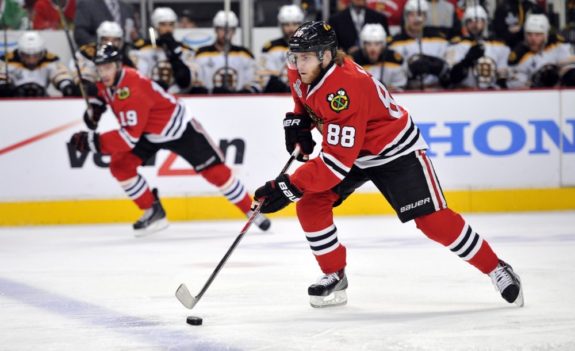
Patrick Kane (Rob Grabowski-USA TODAY Sports) 
Mitch Marner (THE CANADIAN PRESS/Nathan Denette)
Kane notched 76 goals and 230 points in 244 games while Marner tallied 67 goals and 224 points in 241 games. In their final ELC seasons, Kane scored 88 points while Marner scored 94. Right in line with the estimation above, Kane signed a five-year deal for $6.3 million per season, or 11.09 per cent of the cap.
Applying this to Marner and the estimated $83 million salary cap for the 2019-20 season, he should earn around $9 million on a five or six-year deal.
When we look around the league at other comparable contracts signed since 2015, the 11 per cent figure makes perfect sense.

Dubas’ Role
Other than the pure stats, we can’t ignore the role of the general manager in contract negotiations. For all the good he has done, Dubas hasn’t quite proven himself to be the best negotiator.
While the AAV on the Matthews deal is defensible, the five-year term is certainly an eyebrow-raiser. Dubas paid a premium while only retaining the star centreman’s services for one year of unrestricted free agency. If the Leafs remain contenders over the next five seasons, Matthews will likely re-sign, but the fear of him walking will always be there.
The first-year GM also admitted to his poor handling of the Nylander contract.
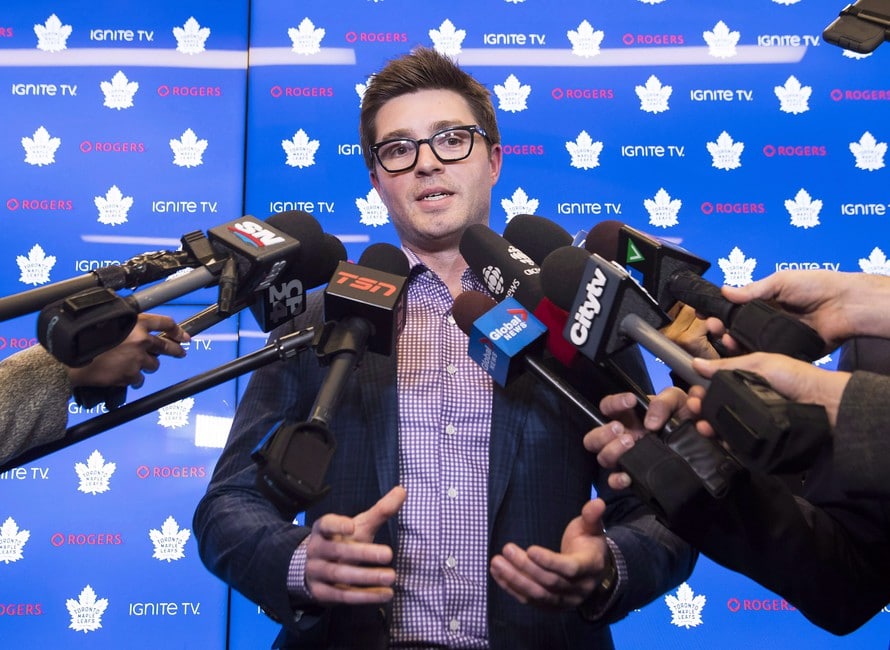
“I think the blame for the situation going that far has to go to me. I don’t think it set up William (Nylander) to have a good season,” he said at the season-ending press conference. “Mitch (Marner) is priority one, so without an answer on Mitch we are going to be at a stalemate.”
The prevailing feeling from the Apr. 25 press conference was that Dubas recognized the mistakes he made with Nylander. He lacked a sense of urgency in getting the deal done, which led to a standoff until the final moments before the Dec. 1 deadline and the 33-year-old GM does not want to repeat that same mistake with Marner.
That’s part of what will make this negotiation so tough for Dubas: he wants to get the contract signed as soon as possible, but not so hastily that he gives Marner whatever he wants. Dubas knows exactly what his star winger is worth and what he can afford to pay him, so he has to stick to his guns.
While the Nylander and Matthews contracts weren’t perfect, they provided valuable experience for the rookie GM. But if he wants to keep the band together, Dubas better make sure he gets the Marner deal right.
Stats from naturalstattrick.com
Salary cap numbers from capfriendly.com